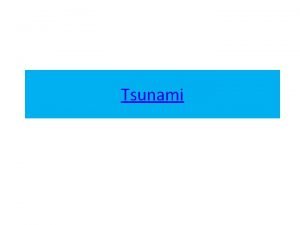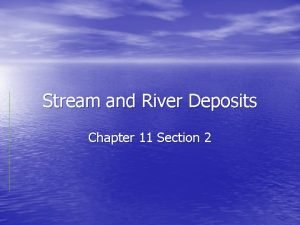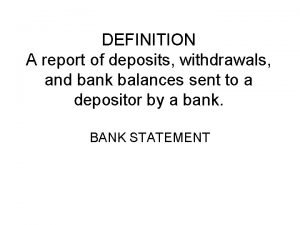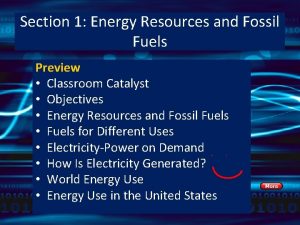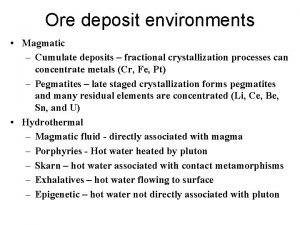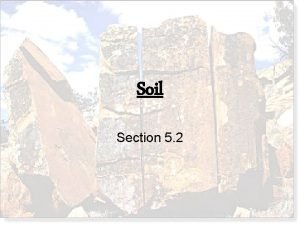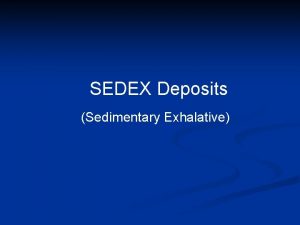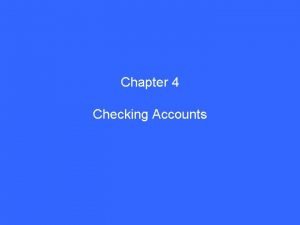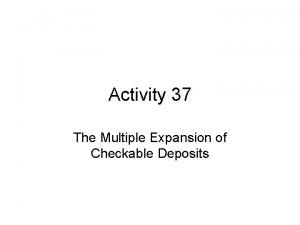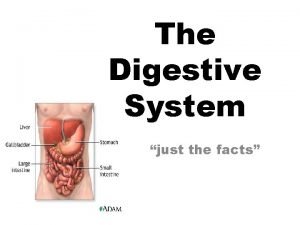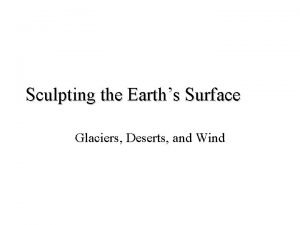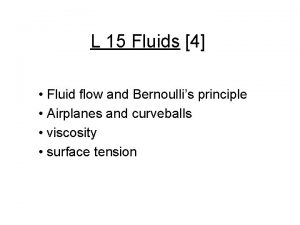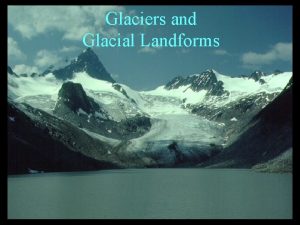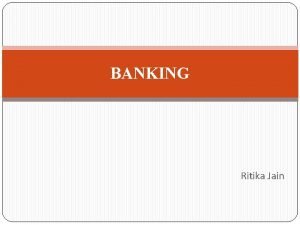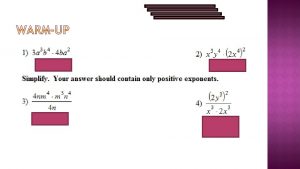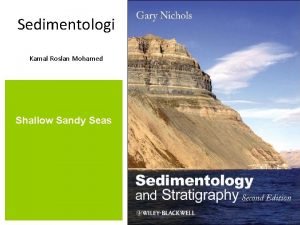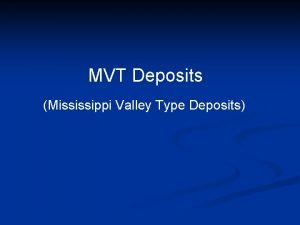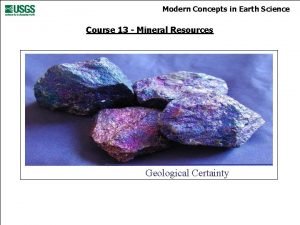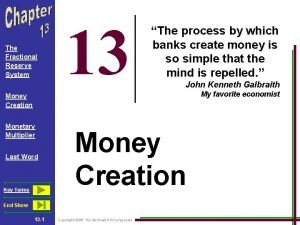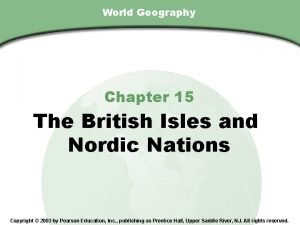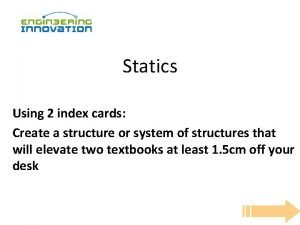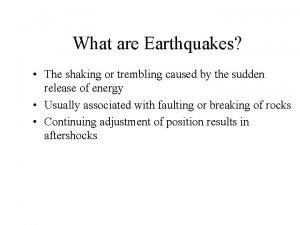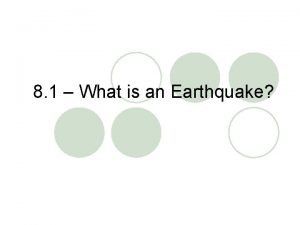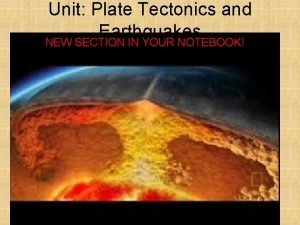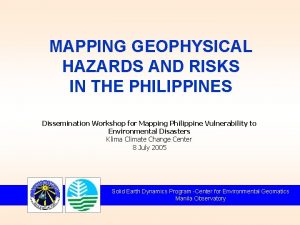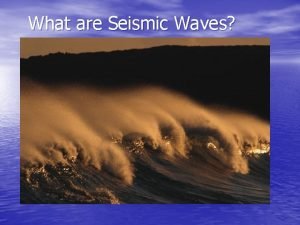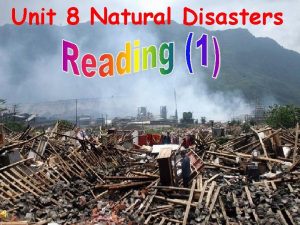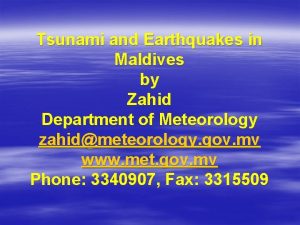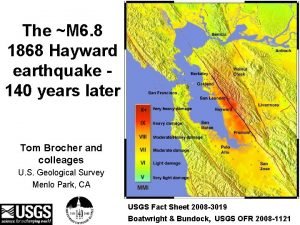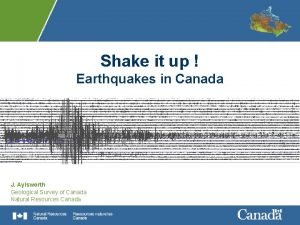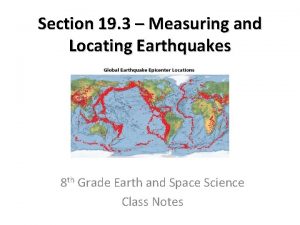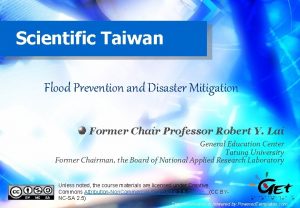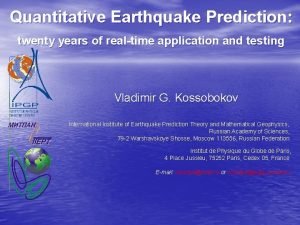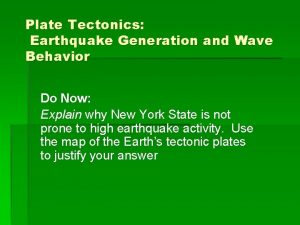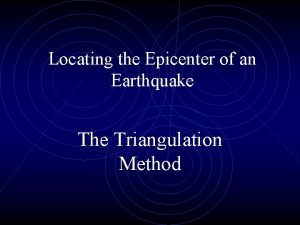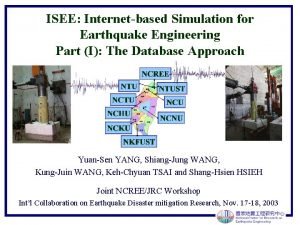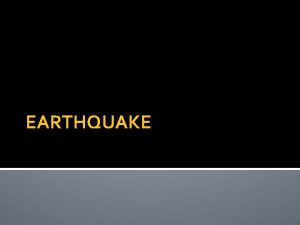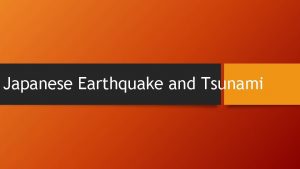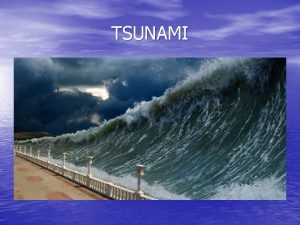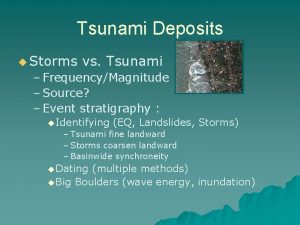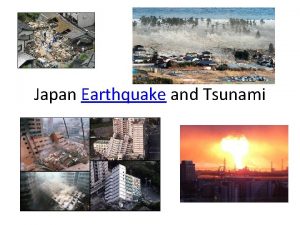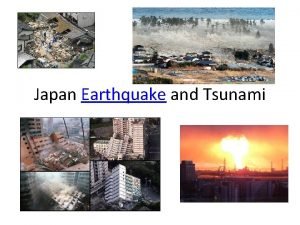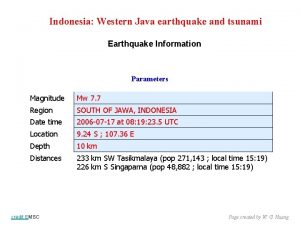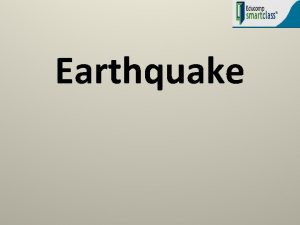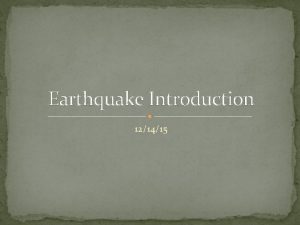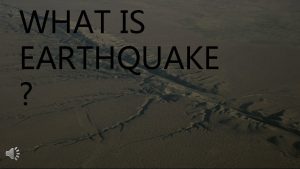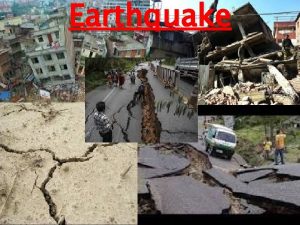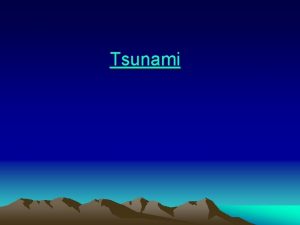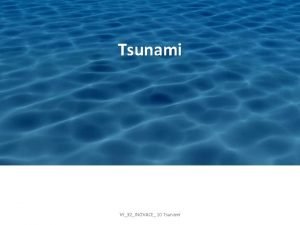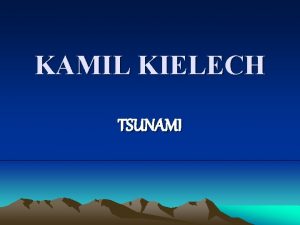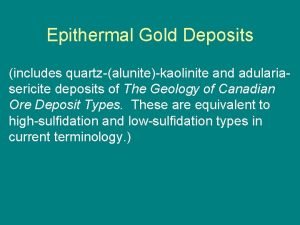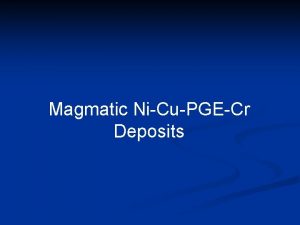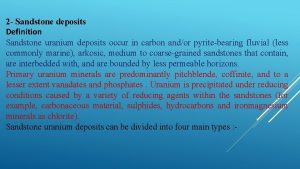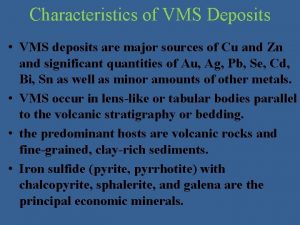Using tsunami deposits to determine earthquake and tsunami













































- Slides: 45

Using tsunami deposits to determine earthquake and tsunami recurrence intervals: opportunities and challenges Jody Bourgeois Earth & Space Sciences University of Washington Seattle, Washington Soldatskaia Bay Kamchatskii Peninsula

We can use (historic and pre-historic) deposits from tsunamis to: • Document tsunami hazard where unknown historically and where prehistoric tsunamis are larger • Help produce probabilistic hazard maps • Calculate tsunami recurrence intervals (typically centuries long) • Understand tsunami behavior • Calibrate, test and enhance tsunami runup modeling • Educate the public

We can use (historic and pre-historic) deposits from tsunamis to: • Document tsunami hazard where unknown historically and where prehistoric tsunamis are larger • Help produce probabilistic hazard maps • Calculate tsunami recurrence intervals (typically centuries long) • Understand tsunami behavior • Calibrate, test and enhance tsunami runup modeling • Educate the public

QUESTIONS: WHERE? HOW BIG? HOW OFTEN? intro

QUESTIONS: WHERE? HOW BIG? HOW OFTEN? intro Problem: Historic records are short and tsunami recurrence intervals are long.

Oldest catalogued tsunami*: Mediterranean 4 th c. B. C. Japan 7 th century China, Central & South America Philippines, Indonesia Russian Far East & Alaska North America, New Zealand 16 th century 17 th century 18 th century 19 th century *classified as definite Lander and Gusiakov, 1997 and online catalogues

How can geology help tell our (hi)story?

Copalis deposit mudflat deposits in years after tsunami deposit grassy field c. 300 years ago Copalis River bank, Washington State coast

Coring at Willapa Bay for the longer tsunami record Mary. Ann coring

This and other cores tell us that large earthquakes and tsunamis occur on the Washington coast every 100 -1000 years (average ~500 years) There are similar records for all of Cascadia and also the Gulf of Alaska ~300 years ago Willapa longer record Atwater, Carver, Clague, Darienzo, Gilpin, Hemphill-Haley, Hutchinson, Kelsey, Nelson, Peterson, Williams, Witter, … Turbidites: Goldfinger, Karlin ~3500 years ago

(compiled by Brian Atwater) Hokkaido n. Japan-Kuril-Kamchatka subduction zone history

Hokkaido Tsunami deposits take the record back thousands of years n. Japan-Kuril-Kamchatka subduction zone history

pre-20 th century tsunami deposits found farther inland Nanayama, Atwater, Satake and several others

Kamchatka n. Japan-Kuril-Kamchatka subduction zone history

profiles tephra stratigraphy excavations tsunami deposits FIELD METHODS marine terraces

Polar w/o ice K-centric

Polar w/o ice K-centric

Polar w/o ice K-centric

“hungry America” model (USGS website) Hungry America

after Fujita Mackey & others Polar with plate boundaries EUR NAM OKH BER PAC

Polar with plate boundaries OKH

Polar with plate boundaries BER

How many and what kinds of plate boundaries? How does Kamchatka coastal neotectonics Three backpackers elucidate this problem?

Cloudy Kamchatka

LARGE Polar with plate boundaries NAM EUR NAM PAC

LARGE Polar with plate boundaries NAM EUR BER OKH PAC

uplifted marine terraces uplift rates mm/yr (m/kyr) for last 500 k years

Mw 7. 7 tsunamigenic earthquake KAMCHATKA LAND

1969 Ozernoi tsunami model (Titov) (snapshots) one possible source configuration

Mw 7. 7 tsunamigenic earthquake KAMCHATKA LAND

peat & tephra Stolbovaya field site Bering Sea coast bumpy tundra

Stolbovaya site Profile 1, trench 104 1969 Ozernoi tsunami deposit -> 1964 Shiveluch volcanic ash -> paleo-tsunami deposit -> Shiveluch c. 1650 A. D. -> paleo-tsunami deposit -> Ksudach caldera c. 250 A. D. ->


one of 14 profiles at Stolbovaya total of >50 excavations

Tsunami frequency per 1000 years

Tsunami frequency per 1000 years Stolbovaya recurrence rate ~1/2 KSZ & greater than many other subduction zones

Mw 7. 7 Ozernoi modeled by 1969 Ozernoi tsunami data and deposits indicates c. 3 m horizontal shortening Recurrence intervals for such tsunamis (from deposits) indicates shortening of c. 15 mm/yr over last 4000 yr

“hungry America” model Hungry America

Fujita, Mackey and others LARGE Polar with plate boundaries NAM EUR BER OKH PAC

Challenges Geochronology Correlation Statistics

Challenges Geochronology Correlation Statistics How many observations are sufficient? What is the preservation factor? (Signor-Lipps)

Challenges Going beyond tsunami recurrence to earthquake recurrence

Challenges Going beyond tsunami recurrence to earthquake recurrence and onward to paleotsunami and earthquake magnitudes

Challenges Paleogeography Paleobathymetry Paleotopography and onward to paleotsunami and earthquake magnitudes

Applications Paleoseismology Neotectonics Archaeology Coastal geomorphology Seismic & tsunami hazards Education & outreach
 Did the nepal earthquake cause a tsunami
Did the nepal earthquake cause a tsunami Chapter 11 section 2 stream and river deposits answer key
Chapter 11 section 2 stream and river deposits answer key A report of deposits withdrawals and bank balances
A report of deposits withdrawals and bank balances Section 1 energy resources and fossil fuels answer key
Section 1 energy resources and fossil fuels answer key Ore deposits
Ore deposits Function of commercial banks
Function of commercial banks Personal bank account 7 habits examples
Personal bank account 7 habits examples Soil that forms on unconsolidated deposits is called
Soil that forms on unconsolidated deposits is called Sedex ore deposits
Sedex ore deposits Lesson 4.6 online banking answers
Lesson 4.6 online banking answers The multiple expansion of checkable deposits
The multiple expansion of checkable deposits Emotional bank account examples
Emotional bank account examples Glacial deposits
Glacial deposits Calcium deposits
Calcium deposits Glacial deposits
Glacial deposits Calcium deposits
Calcium deposits Calcium deposits
Calcium deposits Cirque glacier
Cirque glacier Ritika deposits 200 every month
Ritika deposits 200 every month Sarita deposits $1000 in an account
Sarita deposits $1000 in an account Tidal deposits
Tidal deposits Mvt deposits
Mvt deposits Vms deposits
Vms deposits The fraction of checkable deposits
The fraction of checkable deposits As coal deposits were used up, britain turned to
As coal deposits were used up, britain turned to Using the method of joints determine the force
Using the method of joints determine the force Focus and epicenter of an earthquake
Focus and epicenter of an earthquake Falcon focus
Falcon focus Determining the arrival times between p-wave and s-wave
Determining the arrival times between p-wave and s-wave Focus and epicenter of an earthquake
Focus and epicenter of an earthquake 1958 lituya bay earthquake and megatsunami
1958 lituya bay earthquake and megatsunami Basilan and romblon tsunami
Basilan and romblon tsunami Using system using system.collections.generic
Using system using system.collections.generic Unit 25 special refrigeration system components
Unit 25 special refrigeration system components Seismic wave types
Seismic wave types Unit 8 natural disasters
Unit 8 natural disasters Department of meteorology maldives
Department of meteorology maldives Hayward earthquake 1868
Hayward earthquake 1868 Tectonic plates canada
Tectonic plates canada Earthquake intensity depends primarily on the height of
Earthquake intensity depends primarily on the height of Taiwan flood
Taiwan flood Taiwan earthquake
Taiwan earthquake Shallow focus earthquake
Shallow focus earthquake Earthquake triangulation lab
Earthquake triangulation lab Taiwan earthquake
Taiwan earthquake Sabiha gökçen international airport earthquake proof
Sabiha gökçen international airport earthquake proof
